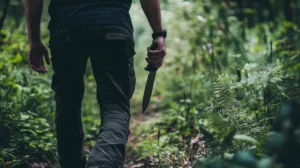Let’s Talk Custom Knife Blades!
You want to customize a knife, eh? Well, you are in luck because today, we’re going to talk all about blade materials to help you choose the right steel for your masterpiece. From the seasoned knife maker to just starting out, choosing the right steel really makes all the difference in performance and durability for your custom knife. So take a seat, stay back, and let’s dive right into the world of blade materials!
Why Steel Matters In Custom Knives
Now, let’s dive right in. Why is steel such a big deal with custom knives? Imagine you’ve spent hundreds of hours designing the perfect knife; got the shape just right, the handle, and the balance. If you cut corners on the steel, all that hard work could be for nothing. The kind of steel you choose is the backbone of the knife. It affects how sharp the blade can be, how well it holds that sharpness, and how resistant it is to the wear and tear of use. There are literally hundreds of different steels, all with their own unique properties: some are super hard and take a wicked sharp edge, and some are more flexible and resistant to chipping. And then, of course, there’s corrosion resistance: some kinds of steels work with moisture and acids without ever rusting, which is rather important if you use your knife in harsh conditions. Before you get caught up in all the flashy design details, remember that the steel’s what counts. After all, it’s what takes a nice-looking knife and makes it functional and reliable.
Checking Out Different Steel Options
Now, immerse yourself in the realm of steel options for your custom knife—there are tons out there with their own little quirks and specialties. Let’s break it down so that you can understand the gist of it all.
First, there are what’s called high-carbon steels: 1095 and O1. These will be your best bet if you want a really sharp blade that can hold its edge for some time. They’re known for their edge retention and can be honed down razor-sharp. The catch—well, they rust easier, so you’ll want to keep them oiled and dry.
Then you’ve got stainless steels like 440C and S30V. These guys are all corrosion-resistant. They’re pretty good, especially if you’re using your knife in wet or humid conditions. Stainless steels are usually a bit tougher to sharpen compared to high-carbon steels; however, they will not rust and hold up really well to the elements of nature!
Tool steels like D2 and A2 are another very good option. They are simply exceptionally tough and hard-wearing; what is more, they can be used for heavy duties without any problem. They may be a bit tricky to sharpen and may not reach the same razor-sharp edge as high-carbon steels, but they’re built to last and handle some serious abuse.
Last but not least are the powder metallurgy steels, such as CPM-20CV and M390. These represent the cream of crop in terms of performance, featuring the best properties of high-carbon and stainless steels that provide great edge holding ability, corrosion resistance, and overall toughness—they simply never die. They are at a premium price, but when you want the very finest, they are to be considered.
What’s important to you in blade steel: sharpness, durability, resistance to corrosion, or some combination of all three? Don’t feel overwhelmed just yet, as a small amount of education on these popular steels will put you well on your way to choosing the perfect one for your custom knife project.
The Lowdown on Stainless Steel
Let’s check in on stainless steel—the holy grail for knives! This material could be compared to some sort of superhero of metals, in that it doesn’t let itself go through rust and corrosion. So, if you live down in the humid parts of the country or right next to the ocean, stainless steel is for you. Yes, it isn’t the sharpest steel out there, but it cleans up really nice and is very easy to keep looking shiny. Furthermore, it won’t be a headache when cleaning is concerned. Now, stainless might not hold an edge quite as well as some of the fancy steels available, but for me, the low-maintenance vibe wins out.
Going Hardcore with High Carbon Steel
Now, on to high carbon steel—the tough cookie of the blade world. This fellow really brings some serious edge retention to the table. If you want a blade that will slice through tasks like a surgeon, then high carbon steel is what you should be getting. Let’s break down why this steel type is such a powerhouse.
First and foremost, high carbon steel simply has more carbon content than the other types, which means it can be hardened to a greater degree. Consequently, this produces a blade that can be very, very sharp and retain that sharpness for a very long period. That’s why so many custom knife makers and pros swear by high carbon steel for tasks that call for precision and longevity.
Another advantage? This steel can take a sharp edge and hold it. Therefore, if you’re using it for bushcraft, hunting, or any heavy-duty outdoorsy activities, you’ll find it performs superbly. High carbon steel, to a large extent, becomes the favorite of many outdoorsmen and craftsmen seeking a dependable blade for harsh conditions because of that strength and razor-sharp sharpness.
However, it’s not all sunshine and rainbows. High carbon does need a little more TLC to keep it in the best shape. Unlike stainless steel, it’s more prone to rust and corrosion, especially when you are in a humid or wet environment. That does mean you will need to keep your blade clean, dry, and occasionally oiled to prevent rust. I mean, don’t be scared off by that—the little maintenance it requires is nothing in consideration of the overall performance and sharpness given by high carbon steel.
From the kitchen to the wild, high carbon steel blades can take the heat—literally. Their sharpness and toughness, in particular, come in a really rare combination in other classes of knives. So, if you’re after a blade that masters edge retention and doesn’t shy away from hard work, then high carbon steel could just turn out to be your ideal choice for a custom knife.
Don’t Forget About Damascus Steel
I promise we didn’t forget about Damascus steel. This classic beauty is not only a feast for the eyes but also a total performance beast. Let’s break down why Damascus steel makes such a big deal and why it may turn into the perfect pick for your custom knife.
Damascus steel is legendary for its rich history and those stunning patterns you see on the blade. Now, how it is made is the real magic: layers of different steels folded together, welded, and hammered out to size—a process repeated over and over. That not only creates those eye-catching wavy patterns but joins the best qualities of each layer into a blade that is at one time beautiful and rugged.
Strength and Durability
The multi-layered construction of Damascus steel makes it very strong and durable. That means the blade will take a beating and stay in one piece, whether you’re chopping through branches or slicing veggies. It’s built to handle tough jobs without letting you down.
Edge Retention
Damascus steel comes with magnificent patterns and high performance due to its makeup of layered different carbon steels. The mix of steels not only decorates the blade, making it highly attractive, but also affects edge retention and hardness. Various carbon steels that forge as Damascus produce different edge retentions and Hardness Rockwell, HRC ratings that hit a blade directly on their durability:. For example, high-carbon steels in Damascus may give extremely good sharpness and edge-holding capabilities, but this hardness affects the durability of the blade as well. Type of steel blend in Damascus determines how resistant a knife is going to be to use, thereby explaining that performance and longevity depend altogether on the type of steel used. Whether it is a blade that will remain sharp for long periods or one that can withstand heavy usage, using carbon steels within Damascus crafting enables this in regard to the creation of blades that exhibit long-lasting durability and functionality.
Unique Patterns
Next to performance, Damascus is all about looks. Every blade displays a unique pattern that comes out from the way it’s made. No two Damascus knives are ever identical, so you own a piece that’s as unique as you are.
Versatility
This does not turn out to be an exclusive collector’s item in Damascus steel; it is highly versatile. Be it a great chef’s knife, heavy-duty hunting blade, or just one that stands out a bit, Damascus steel can do anything.
What’s cool about using a Damascus steel knife is that it has so much history. But there’s also something kind of old-school, über-crafty about it that makes it more than just a tool—it feels like you’re holding a piece of the past.
Essentially, Damascus steel doesn’t stop there at just a good face. This looks well on its credential sheet: strength, durability, and an edge retainer. Whether as collector’s items or users just looking for something that does the job as good as it looks, Damascus steel is certainly something you will want to consider.
Making Your Steel Choice
Now, getting down to the nitty-gritty of how you can make the best choice in selecting the right steel for your custom knife: understand that with so many options out there, things might be a little overwhelming. Just relax and think about these factors—your intended use, maintenance preference, and budget—before taking a dive. Different types of steel vary in advantages and disadvantages; therefore the selection will depend on matching your needs to the characteristics of the steel.
Wrapping It Up: Make Your Custom Knife Strong!
Alright, folks, we’re almost there! Now that you know it all regarding the right steel for a custom knife, it’s time to put it all together so that the blade will be as strong as can be. Keep in mind that regular maintenance is what it takes to keep your knife in tip-top form. Whether weekend warrior or seasoned outdoorsman, treating your custom knife with care will ensure it stands the test of time. Now, go ahead, select the best-suited steel for your needs, treat it a bit with a little TLC, and take off to conquer whatever lies ahead—style and precision in hand! Keep those blades sharp and shining!




